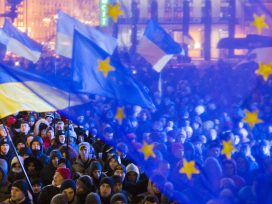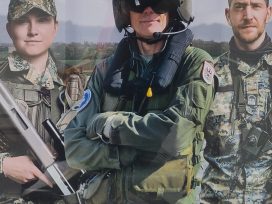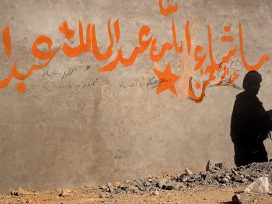Artistic expression can surface from desperate situations. Despite oppression and impoverished circumstances, the self-organization of Ukrainian creatives has led to a special kind of resistance. Collectively taking care through adversity, their practices focus on treating emotional wounds, from the Bucha Massacre to the Holocaust.
Lizaveta German, art historian, curator and founder of the Naked Room in Kyiv, is currently writing a book about the counter offensive of exhibitions. She spoke with anthropologist Taras Fedirko during the Vienna Humanities Festival at the Institute for Human Sciences.
Taras Fedirko: For the Venice Biennale you co-curated a brilliant art project, an installation by the Kharkiv artist Pavlo Makov. The installation for those who aren’t familiar is called Fountain of Exhaustion, Acqua Alta, in Ukrainian Fontan Vysnazhennia.
It is a contraption of hierarchically organized sieves. At the top, one sieve collects whatever is poured into it: water, sand, you name it, whatever can pass through. It passes it on to two sieves, to three and onwards, all the way down to seven or more sieves at the bottom. And as water or sand pass through, they are divided, and as they are divided, they’re exhausted.
A more obvious way of interpreting this – and, mind you, I’m no art critic, I’m an anthropologist and social scientist, so I turn everything back to metaphors of politics and the social – we can read this as a metaphor for Ukrainians’ self-understanding since maybe 2013, 2014, and certainly longer. It’s built hierarchically, yet it is a critique of hierarchy. It’s a statement about the quiet work of resistance that turns hierarchy upside down, that destroys the effectiveness of hierarchical imposition. At the same time, it is also a critique of that collectivism.
Today, we are here to talk about your work on the counteroffensive of exhibitions. Lizaveta is writing a book about where Ukrainian artists found themselves after the full-scale Russian invasion on 24 February 2022. Can you tell us a little bit about that moment and what was so peculiar about the Ukrainian contemporary artists’ response to the invasion?
Lizaveta German: Starting with Pavlo Makov’s piece, the idea comes from the 1990s. Pavlo Makov started his career in the 1970s, but the 1990s was a very crucial moment for his practice. The idea of the fountain of exhaustion and the symbol of exhaustion is very deeply rooted in the post-Soviet Kharkiv situation. The piece is a combination of poetic references and concrete social references to the post-Soviet city – exhausted, deprived of infrastructure.
Those of you who remember the post-Soviet 1990s will recall the absence of water or electricity. Kharkiv in the 1990s was exactly the city which, during the war, didn’t have water for weeks. This is something we are experiencing in Ukraine now, and once again something that brings new meaning to the fountain of exhaustion.
The story of this piece begins in the 1990s but was never realized back then. Makov never managed to produce it as a working fountain for many different reasons. For the Venice Biennale, we offered him the opportunity to actually produce this fountain, to make it work.
He immediately answered with this idea and the image of Acqua Alta, within the context of Venice – the city which is step by step going underwater. It gave a new meaning to the piece. It became a symbol of something more than just a post-Soviet situation, a symbol of exhaustion of economics, politics. We started producing it in 2021 and it was realized two months after the full-scale invasion. Again, it gained new meaning: a symbol of the exhaustion of humanity.
We brought the Fountain of Exhaustion to Kyiv for an exhibition in the Khanenko Museum, one of the few museums in Kyiv that has physically suffered from the shelling. The exhibition was made possible by a heroic team who managed to do everything to open this project. Now we are bringing this piece to Kharkiv, the hometown of Pavlo, and a city even more damaged by the war. The further this piece goes, the more it has been exhibited, the more meaning it gains. I don’t want to go into artist prophecies, but this piece predicted certain things back in the 1990s.
I borrowed the term ‘counteroffensive exhibitions’ from two artists: Stanislav Turina and Kateryna Libkind. They are artists who both curated and opened exhibitions in Kyiv after the full-scale invasion. In May and June 2023, exhibitions were opening in Kyiv literally every day. Like pub crawling, people started exhibition crawling instead. It has been an amazing thing to follow, because suddenly it wasn’t like a pre-war situation, it was even more active, fruitful, diverse and interesting.
Ukraine remains at a moment of high artistic productivity, but, most importantly, the exhibition as a format has grown even more relevant. Since permanent collections need protection, they remain hidden in museums and institutions. Instead, they can exhibit self-organized initiatives.
If we look back at the nineteenth century, the exhibition format was a privileged space for aristocracy and academia. Now, the exhibition space has become a public domain. It is a meeting point, a place for debate. Here, we can exhibit not just art but ourselves and the Ukrainian art scene. We are here, we are alive, active and not defeated. I think this is why the term ‘counteroffensive exhibitions’ popped up, because it illustrates the ability to resist collectively.
Taras Fedirko: You talk about self-organization as a founding part of the resistance to the war. Can you tell us a little bit about what has made this resistance possible? There seem to be longer traditions of exhibitions as a form of resistance.
Lizaveta German: Self-organization and this type of horizontal work is one of the core elements of the artistic process in Ukraine. Starting from the 1960s (when my expertise also began), it derives from Soviet censorship. Obviously, there were many artistic communities that didn’t have enough opportunities to be exhibited, who never stood a chance of passing through the selection process and committees based on ideological and formal standards.
Artists had to self-organize somehow. In Odesa, the phenomenon of apartment exhibitions appeared, or so-called ‘fence exhibitions’, where artists exhibited several pieces on the fences around the Opera in the city centre. These exhibitions went on for hours and were documented with photos.
Kyiv had less self-organization. The art historian Boris Lobanovsky describes it as ‘Kyiv for monks’. Self-organization wasn’t as visible there as it was in Odesa. In Kyiv, exhibiting was more about little circles with groups of people who gathered together to discuss and show work to one another. It is still a form of self-organization, striving to be together, making the work public, even if it was just for 10 people.
I won’t give you a lecture on the 1960s, but I do think this is where this tradition of doing something despite obstacles took shape. The obstacles back then were politics, the Soviet art system that didn’t allow certain artistic expression.
The 1990s meant that while the Soviet artistic infrastructure more or less collapsed, the new infrastructure didn’t immediately emerge. Many things that happened in the 1990s happened more or less through self-organization. Initiatives took place in different venues, sometimes literally in ruins. One example is the Soros Center for Contemporary Art near the famous Kyiv Mohyla Academy. Before the foundation moved in, the venue in a half-ruined state was used for exhibitions, curated by the artists themselves. The ruin as a backdrop, or as a prop, inspired several artists to create self-organized site-specific exhibitions.
The 2000s were mainly characterized by the Orange Revolution, which gave a big impulse to artists. We sometimes call them the post-Orange generation, one example being the R.E.P. Group that is one of the most celebrated and known for a reason. Mykola Ridnyi is also part of this generation. During the revolution, he established together with his colleagues from the SOSka group, a beautiful, self-organized gallery in Kharkiv city centre that existed for 15 years on zero budget, without support.
For a very long time, it served as one of the few real centres for alternative culture. For many years, this little hut was the only place for musicians and contemporary young artists to meet to arrange concerts and performances. Even Boris Mikhailov, a famous Kharkiv artists and photographers, went to SOSka because there was nowhere else to go. It is a story that proves how self-organized initiatives played a huge role in establishing several generations of Ukrainian artists. During this time, self-organized exhibitions of different forms and shapes were also very powerful in Lviv and Uzhhorod. These places have made a huge impact on generations of Ukrainian artists that gained no recognition from institutions.
Back to the present day, the full-scale invasion is the worst thing that can happen to the country and to the city. It is much worse than the decline of the 1990s or the lack of financial support in 2000 or 2010. This kind of liveability remains, because this force of self-organizing is more or less in our DNA.
We could see it from day one. I know of many initiatives that emerged literally during the first week of the full-scale invasion. In Kyiv, for instance, people were sitting at home during 72 hours of curfew, calling each other, chatting on Facebook, saying: ‘let’s do something!’
We need to remember that many things were coordinated in Kyiv because the region was under less threat in the beginning. Artistic residencies were quickly set up to relocate artists from different parts of Ukraine. The organizers thought: it is not just our mission to give shelter and to provide a place to live, we need to give artists a place to do something together. I think this especially had a very important psychological effect. Many artists that I spoke to talked about the feeling of disorientation and confusion. The ability to then take part in a workshop, talk to your peers, your friends, not with the aim of producing a painting or an installation, functioned like therapy.
Still, this therapy made artistic results. What was produced during this residency was later exhibited in, for instance, Vienna and Berlin and is still going around. We can now go and see the exhibitions which show us the product, the fruits of these very immediate thoughts and traumas. So, I do claim that this self-organization, this impulse as I call it, is something very Ukrainian. And I’m sure this impulse can be found in several war-torn countries.
Taras Fedirko: The fact that several generations through the decades have had to self-organize – firstly, because of a strong state taking away institutional possibilities, and then because of a weak state taking away institutional possibilities – suggests that it isn’t just continuity that responds to these conditions but something in the DNA. These counteroffensive exhibitions are not just a moment of collaboration and coordination but clearly a moment of exuberance, of creativity. Do you see any new artistic form or artistic expression, new ways of talking about the war or depicting the war, emerging? Do you see new kinds of responses that are changing Ukrainian art on artistic terms?
Lizaveta German: Maybe it’s still too early to make general conclusions about artistic language. And I should add that I relocated from Ukraine in April 2022, so here I am both speaking as an expert but also as a distant observer. But I am still very much an insider, a part of the artistic Ukrainian communities. Therefore, I can share several observations not just made by me. I talk to my colleagues, peers and friends who are dear to me and whose observations I trust, and try to grasp what is happening.
The artist Stanislav Turina’s observation was interesting when I asked him a similar question. He said that he feels art has become safer, less critical, or the best word might be ‘careful’. He could not explain in which particular way – mainly because he was also expressing this very carefully. I think there are so many sensitive topics to talk about, examples being the Bucha Massacre, or life in occupied cities and territories – all topics that are still bleeding.
I think this safeness, secureness or carefulness is an expression of respect towards this. Ukrainian society is learning, maybe for the first time since independence, to remember things, learn to work with the trauma. The topic of Holodomor – or even more the topic of the Holocaust – hasn’t been discussed to the extent that it should have. I think what this state of war teaches us as a society but also as artists is to speak about the trauma, its deepness and painfulness. To do this, you have to be careful.
The carefulness, or do I dare say ‘fear’ of not being patriotic enough holds a thin line, and a risk of being caught up inside nationalistic, exuberantly patriotic discourse. I think it’s a balance that Ukrainian artists are trying to hold. So far, I don’t see any dangers of this from the Ukrainian art scene. Discursive carefulness is a complicated thing, but I’m really curious about what it will look like.
The contemporary art scene has also retained its independence due to the conditions that existed from the 1990s to the 2010s. State institutions like the Ministry of Culture and national museums were not very active or supportive during this time. Now the state is busy with heritage protection or cultural diplomacy, which leaves the contemporary scene more or less on its own again. I still think the contemporary scene acts more or less independently. And without state support it can remain critical.
Taras Fedirko: Fierce discussions across the cultural sphere in Ukraine about taking or not taking part in international events together with Russian artists, curators and writers have been integrated into global discussions on inclusion and exclusion, censoring versus giving voice. A Ukrainian lack of desire to collaborate with Russian artists and or Russian speakers is being interpreted simply as exclusion and as identity politics. What is at stake for Ukrainian artists taking part in these debates, inside the artistic community? Why do artists from Ukraine care so much about being seen or not being seen with Russians?
Lizaveta German: This is indeed a very sensitive topic. There is one line of discussion which says: no, we won’t participate in any collaboration, that cooperation is impossible right now because these communities speak from very different positions, the Ukrainian position being under direct, physical threat. Many artists remain in Ukraine, producing new work in complete darkness, in cold apartments without electricity. Or they have to leave their home.
This physical condition and this sensitivity towards the situation cannot be removed from the art. You cannot produce without the background of the production. We are speaking from very different ethical and physical positions. Forming a united one is impossible. And this level of awareness and level of sensitivity results in a lack of dialogue.
Ukrainian art and Ukrainian culture in general have been so underrepresented, many artists have sometimes been labelled as Russian artists in museums. Ukrainian art was exhibited in many cultural projects like a younger sister, almost like in Soviet times. This image has lived on, and I think the protests against joint Russian and Ukrainian projects are a protest against this artificial coexistence, against representing this post-Soviet art scene.
The private level is also important. Many Russian artists and cultural practitioners have relocated and have expressed solidarity with Ukraine. But personally – and I am not alone in this – I have not received a single message from any of the people that I know in Russia. We have not shared enough solidarity or talked about it enough. As we discuss and try to reach a certain point of mutual understanding, it might get better. I don’t wish to say that this position is shared by every single artist and curator in Ukraine. There are multiple visions and I think all of them deserve respect. But I consider that ethical limits are too strong and shared exhibitions are too early right now. It would be too complicated to speak about certain things in the same voice, in the same manner.
This interview took place on 30 September 2023 during the Vienna Humanities Festival at the Institute for Human Sciences.
Published 18 December 2023
Original in English
First published by Eurozine (transcript) / Institute for Human Sciences (IWM) (video documentation)
Contributed by Institute for Human Sciences (IWM) © Lizaveta German / Taras Fedirko / Institute for Human Sciences (IWM) / Eurozine
PDF/PRINTIn collaboration with
In focal points
- Not epistemic enough to be discussed
- Another lost generation of art?
- A trace of Russia at the heart of Austria
- What makes a humanist kill?
- Something happens, somewhere
- Vertical occupation
- No longer a footnote
- The Ides of March
- Counteroffensive exhibitions
- No peace without freedom, no justice without law
Newsletter
Subscribe to know what’s worth thinking about.
Related Articles

An emotive rift exists between being drafted and signing up for military service. Those who prioritize family responsibilities, education and skills, and non-violence aren’t backing the opposition. Defence comes in many forms. Could lessons from Ukraine’s mobilization inform the recruitment challenges potentially facing the rest of Europe?

For those who suffered the consequences of Yalta’s division of Europe, the Helsinki Final Act brought grounds for optimism. Today, as Russia’s regressive war on Ukraine reopens old conflicts, it stands as a monument to European modernity.






